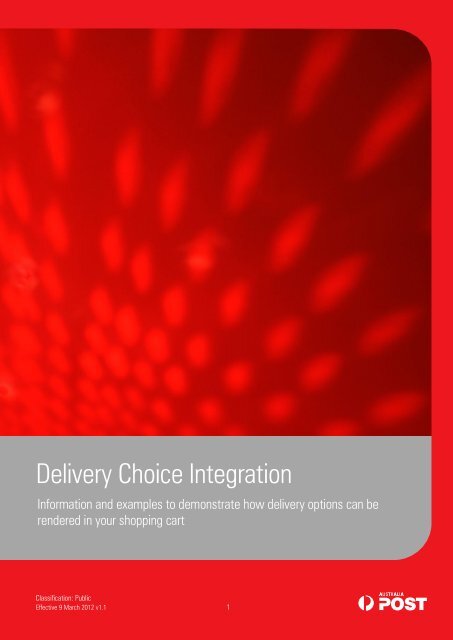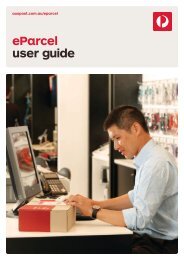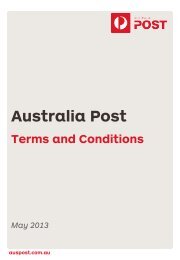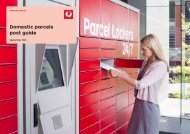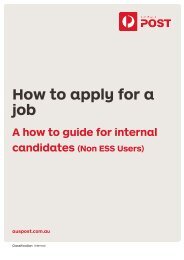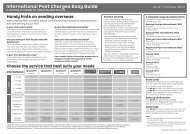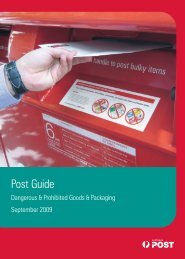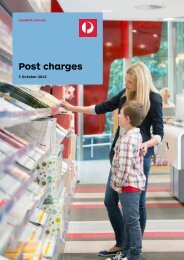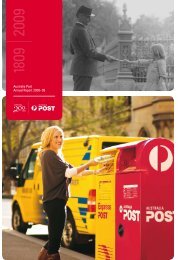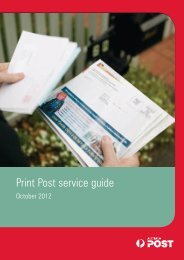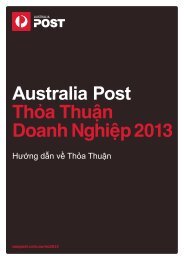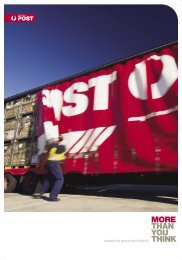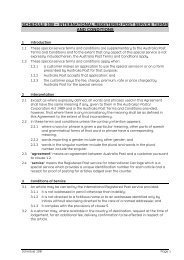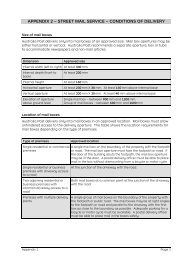Delivery Choice Integration - Australia Post
Delivery Choice Integration - Australia Post
Delivery Choice Integration - Australia Post
Create successful ePaper yourself
Turn your PDF publications into a flip-book with our unique Google optimized e-Paper software.
<strong>Delivery</strong> <strong>Choice</strong> <strong>Integration</strong><br />
Information and examples to demonstrate how delivery options can be<br />
rendered in your shopping cart<br />
Classification: Public<br />
Effective 9 March 2012 v1.1<br />
1
Contents<br />
1. About this document 3<br />
2. What is delivery choice? 4<br />
3. Why offer delivery choice? 6<br />
4. <strong>Delivery</strong> choice Application Programming Interfaces (APIs) 7<br />
5. APIs grouped by function 9<br />
6. Rendering delivery choice in the shopping cart 12<br />
7. Other considerations for best practice shipping 16<br />
8. Getting the most out of delivery choice 17<br />
9. My Deliveries 19<br />
Visit My Deliveries for additional information or to register for personal access. 19<br />
Appendix 1 – GUI Examples 20<br />
<strong>Delivery</strong> <strong>Choice</strong> <strong>Integration</strong> 2 Classification: Public
1. About this document<br />
<strong>Australia</strong> <strong>Post</strong> offers a range of <strong>Delivery</strong> <strong>Choice</strong>s, which online retailers can integrate into their shopping carts or mail order<br />
companies into their business systems, providing their customers with greater delivery convenience. This document<br />
outlines and explains our delivery choices and provides information about how they can work within your shopping cart and<br />
with your chosen <strong>Australia</strong> <strong>Post</strong> lodgement system.<br />
This document also explains why delivery choice is important to the customers’ online experience, and how delivery choice<br />
can improve conversions and drive loyalty.<br />
Our delivery choices are available for integration with external websites by way of Application Programming Interfaces<br />
(APIs), used by web developers. The APIs are presented individually and grouped by function for explanatory purposes.<br />
Graphical User Interface (GUI) examples have been provided to demonstrate how the various delivery choices may be<br />
rendered in your shopping cart. This view also demonstrates how the functionality may be explained within a shopping<br />
cart, with example messaging and notes.<br />
You may choose to offer one or more delivery choices and the flow of the GUI examples provides some guidance on how to<br />
do this.<br />
Technical documentation is provided separately, along with some sample code, to make integration as seamless as<br />
possible. <strong>Delivery</strong> <strong>Choice</strong> Technical Specifications<br />
<strong>Delivery</strong> <strong>Choice</strong> <strong>Integration</strong> 3 Classification: Public
2. What is delivery choice?<br />
<strong>Delivery</strong> choice is about offering your customers the ability to select when and where their parcels are delivered so as to<br />
provide them optimum convenience.<br />
<strong>Australia</strong> <strong>Post</strong> assists you to do this by providing the following parcel delivery options:<br />
1. Speed of delivery – standard delivery 2- 5 working days or express delivery overnight within the specified<br />
network.<br />
2. Location of delivery – recipients can select one of <strong>Australia</strong> <strong>Post</strong>’s Customer Collection Locations or provide a<br />
postal address.<br />
3. Day and Date of <strong>Delivery</strong> – recipients can elect to specify the day/s of the week or a specific date they wish to<br />
receive deliveries. Conversely recipients can elect days of the week they would prefer not to receive deliveries. In<br />
addition, merchants can specify an embargo on delivery whereby an item is not to be delivered prior to a specific<br />
date 1 .<br />
4. Time – recipients can elect to request an AM or PM delivery.<br />
For added flexibility, day and time choices, date and time and location and day or date choices can be combined.<br />
<strong>Delivery</strong> <strong>Choice</strong> Products<br />
<strong>Delivery</strong> choices are available for parcels lodged with <strong>Australia</strong> <strong>Post</strong> via the eParcel or Click & Send lodgement systems.<br />
Listed below are the delivery choices available to specific products within these suites:<br />
eParcel Lodged Articles<br />
Standard eParcel - Location, Day & Date and Time available<br />
Identity on <strong>Delivery</strong> - Location, Day & Date and Time available<br />
Express – Location (NB. timed delivery windows are only available from second delivery day and are not<br />
applicable to next day delivery at this time)<br />
Cash to collect – Location (Collect from outlet only), Day & Date and Time available<br />
Click & Send<br />
Parcel <strong>Post</strong> plus Tracking - Location, Day & Date and Time available<br />
Parcel <strong>Post</strong> plus tracking with Signature - Location, Day & Date and Time available.<br />
Flat rate satchels and flat rate boxes - Location, Day & Date and Time available.<br />
1 The embargo date must be within 14 days of manifest submission and article lodgement.<br />
<strong>Delivery</strong> <strong>Choice</strong> <strong>Integration</strong> 4 Classification: Public
1. Select an <strong>Australia</strong> <strong>Post</strong> outlet from a specified list for your parcel to be delivered to and collected by the recipient.<br />
<strong>Delivery</strong> <strong>Choice</strong> <strong>Integration</strong> 5 Classification: Public
3. Why offer delivery choice?<br />
<strong>Delivery</strong> of the order is the one truly physical interaction a customer has with an online merchant – failure at delivery<br />
compromises the entire customer experience, no matter how great the digital component may be.<br />
In <strong>Australia</strong>, there are very few retailers who have initiated delivery choice; a lost opportunity for improving conversions and<br />
building a stronger connection with customers. The most successful online retailers in the world understand the delivery<br />
stage of the customer journey is one of the most critical – it is an opportunity to drive extra value, strengthen trust and<br />
improve the customer relationship.<br />
We have researched this topic at length and present the following key insights:<br />
94% of online shoppers prefer a choice of delivery options to trade off price and speed<br />
depending on needs 1<br />
Insight: The overwhelming majority of consumers would like to have options to consider for delivery, so they can choose<br />
with a click to pay more for faster delivery or opt for the standard timeframe.<br />
45% of online shoppers say their delivery preference changes greatly depending on the<br />
product they are choosing 2<br />
Insight: Almost half of online shoppers surveyed prefer different delivery options for different products or occasions.<br />
Retailers who only offer single delivery options may lose these customers to comparable retailers offering choices to meet<br />
the customers varying needs.<br />
68% of consumers rate choice of delivery options as an important feature of an online<br />
shopping website 3<br />
Insight: More than two thirds of <strong>Australia</strong>n consumers surveyed rate delivery choice as a fundamental ingredient of an<br />
online shopping website, yet very few <strong>Australia</strong>n online retail businesses offer delivery options. Therefore two thirds of<br />
<strong>Australia</strong>n consumers may be frequently disappointed not to see delivery options offered at the point of purchase. <strong>Choice</strong><br />
of delivery options was considered more important than product reviews and ratings by those surveyed.<br />
33% of consumers say they would shop more online if a greater choice of delivery<br />
options was provided 4<br />
Insight: Retailers have an opportunity to increase sales volumes by offering delivery choice, with a third of consumers<br />
surveyed declaring they would buy more online if more choices were offered.<br />
48% of online shoppers abandoned purchases at checkout due to the delivery options<br />
offered 5<br />
Insight: The delivery options advertised, including price, timeframe and brand of carrier, have a huge impact on the<br />
reduction of shopping cart abandonment.<br />
1. Source: Stress Free Shopping Campaign Effectiveness Survey, <strong>Australia</strong>, 2011<br />
2. Source: Stress Free Shopping Campaign Effectiveness Survey, <strong>Australia</strong> 2011<br />
3. Source: AMR Interactive E-Tailing Survey, <strong>Australia</strong><br />
4. Source: AMR Interactive E-Tailing Survey, <strong>Australia</strong><br />
5. Source: Stress Free Shopping Campaign Effectiveness Survey, <strong>Australia</strong> 2011<br />
<strong>Delivery</strong> <strong>Choice</strong> <strong>Integration</strong> 6 Classification: Public
4. <strong>Delivery</strong> choice Application Programming<br />
Interfaces (APIs)<br />
An API is a particular set of rules ('code') and specifications that software programs<br />
can follow to communicate with each other. It serves as an interface between different<br />
software programs and facilitates their interaction, similar to the way the user<br />
interface facilitates interaction between humans and computers.<br />
Source: Wikipedia.<br />
<strong>Australia</strong> <strong>Post</strong>’s delivery choice APIs are designed to provide flexibility in the choices offered to consumers and flexibility in<br />
how you price your delivery – whether free, flat rate, variable or a combination.<br />
The following list describes the delivery choice APIs that are currently available and an explanation of what they do.<br />
<strong>Delivery</strong> <strong>Choice</strong> APIs<br />
Number Name Description Use<br />
1. Customer Collection<br />
Points<br />
Searches for available collection points and<br />
associated data relevant to the customers query.<br />
<strong>Post</strong>code search returns locations that border the<br />
postcode as well as those directly located within<br />
it. It also describes the type of collection point,<br />
access days and hours and address, of the<br />
collection point.<br />
2. Query <strong>Delivery</strong> Timeslots Returns all delivery timeslots available for each<br />
day of the week and the times associated with<br />
that particular day.<br />
3. <strong>Post</strong>code Capability Returns the services available for a postcode<br />
(standard &/or timed)for each day of the week.<br />
Eg. Express, timed deliveries<br />
4. Query Tracking Queries the current status for a consignment or<br />
article.<br />
This API can be used to display white label (your<br />
own branding) tracking on your website.<br />
5. <strong>Delivery</strong> Dates Returns a list of 10 delivery dates available for an<br />
article/consignment based on the lodgement<br />
date, from/to locations and the network used to<br />
deliver the product type. Always presents the<br />
expected delivery date first followed by nine<br />
additional dates.<br />
6. Validate <strong>Australia</strong><br />
Address<br />
Checks the delivery address and returns one of<br />
three responses: exact match with <strong>Delivery</strong> Point<br />
Identifier (DPID), no match, no DPID.<br />
7. Customer Details Allows merchants to provide customers with<br />
access to their My Deliveries account (see<br />
section 9 for more information on My Deliveries),<br />
saved delivery addresses and preferences. An<br />
authorisation access token will be provided to<br />
you, to return customer address and delivery<br />
preferences. The token is valid for 15 minutes.<br />
This should be used as reference<br />
data. The API should be called initially,<br />
then held locally & updated<br />
periodically.<br />
This should be used as reference<br />
data. Called initially, then held locally<br />
& updated periodically.<br />
This should be used as reference<br />
data. Called initially, then held locally<br />
& updated periodically.<br />
This needs to be called in real time for<br />
all queries.<br />
This needs to be called in real time for<br />
all queries.<br />
This needs to be called in real time for<br />
all queries.<br />
This needs to be called in real time for<br />
all queries.<br />
<strong>Delivery</strong> <strong>Choice</strong> <strong>Integration</strong> 7 Classification: Public
8. oAuth Authorisation Allows My Deliveries 1 customers to share their<br />
addresses and preferences stored in My<br />
Deliveries with a merchant without having to<br />
provide their username and password.<br />
This needs to be called in real time for<br />
all queries<br />
NB. <strong>Australia</strong> <strong>Post</strong> recommends that API data held locally should be updated no less frequently than monthly and no more<br />
frequently than weekly.<br />
API groupings for access<br />
When registering to access the above APIs (API registration), you will need to nominate those you are interested in. They<br />
are grouped as follows:<br />
1. oAuth (token assignment);<br />
2. Customer Collection Points, <strong>Delivery</strong> Dates, <strong>Delivery</strong> Timeslots, <strong>Post</strong>code Capability<br />
3. Query Tracking; and<br />
4. Validate <strong>Australia</strong>n Address.<br />
1. Refer to section 9 for information on My Deliveries<br />
<strong>Delivery</strong> <strong>Choice</strong> <strong>Integration</strong> 8 Classification: Public
5. APIs grouped by function<br />
The APIs have been grouped by function to help demonstrate them to full advantage.<br />
These APIs can be integrated into your shopping cart and the options selected by your<br />
customers included as part of your <strong>Australia</strong> <strong>Post</strong> eParcel or Click & Send consignment<br />
information.<br />
Accessing My Deliveries address book<br />
For information on My Deliveries, refer to Section 8.<br />
I want my customers to be able to access their My Deliveries account and return their preferred delivery address from their<br />
stored data.<br />
Benefit: Saves customers having to type in address details or remember addresses. In addition, the parcel tracking number<br />
will be automatically populated in their My Deliveries watchlist so they have visibility of the parcel during its delivery<br />
journey.<br />
APIs required: oAuth Authorisation & Customer Details<br />
API Name Description Real time call required<br />
Customer Details Customer is requesting access to saved delivery addresses and<br />
preferences<br />
oAuthorisation Allows My Deliveries members to share their private resources<br />
(addresses and preferences) stored in My Deliveries.<br />
Example: For an example of this option rendered in a shopping cart, refer to examples 1, 5 and 6.<br />
Provide expected delivery date and available delivery dates<br />
I want to provide my customers with both the expected delivery date and a range of dates available should they wish to<br />
select a more convenient date for delivery.<br />
Benefit: Provides customers with certainty, presents a professional image and aids selection of timed delivery services.<br />
API required: <strong>Delivery</strong> Dates<br />
API Name Description Real time call required<br />
<strong>Delivery</strong> Dates Returns the expected delivery day for delivery of an article /<br />
consignment and a list of next available delivery dates specific<br />
for the chosen service (expected day and the next 9 days).<br />
Always presents the expected delivery date first based on the<br />
service being used and from / to locations and the (merchant<br />
specified) time to pick and pack.<br />
Important:<br />
Using the <strong>Delivery</strong> Dates API requires that you establish accurate business rules to take into account the time needed to<br />
pick, pack and dispatch. By doing this, an accurate ETA can be provided to your customers - based on both your time to<br />
dispatch and our time to deliver. Accuracy is also critical where you wish to provide further delivery dates and times from<br />
which the customer can choose, as these commence from the first available delivery date for that service based on your<br />
despatch and our delivery times.<br />
Timed deliveries are not available on the expected day of delivery (day 1)<br />
Allow for public holidays when determining despatch date<br />
We recommend when presenting delivery dates for express services that a maximum of three dates are presented to your<br />
customer. This prevents the customers from inadvertently selecting a higher priced service that could have been provided<br />
via the standard service offer.<br />
Example: For an example of this option rendered in a shopping cart, refer to example 9.<br />
<strong>Delivery</strong> <strong>Choice</strong> <strong>Integration</strong> 9 Classification: Public<br />
Y<br />
Y<br />
Y
Present timed delivery options<br />
I want my customers to choose from a range of delivery dates for an article and to choose an AM / PM delivery (if available<br />
for their postcode).<br />
Benefit: Provides your customers with the convenience of having a parcel delivered when they plan to be home or to fit in<br />
with their schedules.<br />
APIs required: <strong>Post</strong>code Capabilty, <strong>Delivery</strong> Dates & Query <strong>Delivery</strong> Timeslots<br />
API Name Description Real Time Call Required<br />
<strong>Delivery</strong> Dates Returns the expected delivery day (or ETA) for delivery of an article /<br />
consignment and a list of available delivery dates specific for the chosen<br />
service (expected day and the next 9 days). Always presents the<br />
expected delivery date first based on the service being used, from / to<br />
locations and the network for that product.<br />
<strong>Delivery</strong><br />
Timeslots<br />
Returns all delivery timeslots available for each day of the week and the<br />
times associated with that particular day.<br />
Important: Using the Query <strong>Delivery</strong> Dates API requires that you establish accurate business rules to take into account the<br />
time needed to pick, pack and dispatch. By doing this an accurate ETA can be provided to customers - based on both your<br />
time to dispatch and our time to deliver. Accuracy is also critical where you wish to provide further delivery dates and<br />
times from which the customer can choose, as these commence from the first available delivery date.<br />
We recommend presenting a maximum of 3 dates for the express service to prevent your customer selecting a higher<br />
priced services that can be delivered by the standard service.<br />
Note: It’s important the recipient’s email and phone numbers are passed to the manifest so we may notify the recipient in<br />
the event there is a problem with their delivery; EG. if they are not at home when delivery is made.<br />
Example: For an example of this option rendered in a shopping cart, refer to examples 9 and 10.<br />
Provide Customer Collection Points<br />
I want to allow my customers to collect their item/s from an <strong>Australia</strong> <strong>Post</strong> outlet of their choice.<br />
Benefit: Provides a convenient alternative for customers who aren’t at home to receive goods requiring a signature or who<br />
don’t keep set work or home hours. It is also a great convenience for customers who work, live or pass by an <strong>Australia</strong><br />
<strong>Post</strong> outlet throughout the day / week.<br />
APIs required: Customer Collection Points<br />
Name Description Real time Call required<br />
Customer<br />
Collection<br />
Points<br />
Searches for available collection points and associated data<br />
relevant to the customer’s query. <strong>Post</strong>code search returns<br />
locations that border the postcode as well as those directly<br />
located within it. It also describes the type of collection point,<br />
access days and hours, address and if applicable the number<br />
of lockers at the collection point. We recommend you display<br />
this data to ensure a positive customer experience.<br />
Important: It’s important (and a requirement of the service) that the recipient’s email is passed to the manifest so we may<br />
notify the recipient their item is ready for collection. The recipient will be required to provide this notification to collect their<br />
parcel.<br />
Their email address may also enable verification of them as a My Deliveries member, thereby providing them with access<br />
to full tracking, redirect and reschedule functionality (where applicable) within My Deliveries.<br />
Note: A signature is captured upon collection.<br />
Example: For an example of this option rendered in a shopping cart, refer to examples 2 and 3.<br />
<strong>Delivery</strong> <strong>Choice</strong> <strong>Integration</strong> 10 Classification: Public<br />
N<br />
Y<br />
N
Provide address validation<br />
I want to provide address validation to my customers.<br />
Benefit: Reduces addressing errors and undeliverable items - enabling <strong>Australia</strong> <strong>Post</strong> to deliver right first time, improving<br />
the overall customer experience.<br />
API required: Validate <strong>Australia</strong>n Address<br />
API Name Description Real Time Call Required<br />
Validate<br />
Address<br />
Checks the typed delivery address and returns one of three<br />
responses: exact match with DPID, no match, no DPID. We<br />
recommend you allow any of these can be overridden by the<br />
customer.<br />
Checks the address that has been typed or imported by the<br />
customer against <strong>Australia</strong> <strong>Post</strong>’s postal address file to ensure<br />
its accuracy and therefore efficient delivery.<br />
Example: For an example of this option rendered in a shopping cart, refer to example 4.<br />
Provide tracking from my website<br />
I want to provide parcel tracking on my website, for products purchased from my website, for the convenience of my<br />
customers.<br />
Benefit: Provides customers with peace of mind by being able to view the status of their item throughout the delivery<br />
journey, improving the overall customer experience and reducing enquiries regarding parcel status.<br />
API required: Display query tracking<br />
API Name Description Real Time Call required<br />
Query<br />
Tracking<br />
Event query for a consignment or article which returns the<br />
current status.<br />
Note for eParcel Users: lodgement APIs are not required if you are integrated with eParcel, but you will need to change<br />
your file format to incorporate this new information. For more information refer to your copy of the eParcel Consignment<br />
Import Guide v3.8 if you import CSV files to eParcel Online , or the eParcel Using Customers Own Systems via Secure FTP<br />
v3.15if you are an integrated customer.<br />
<strong>Delivery</strong> <strong>Choice</strong> <strong>Integration</strong> 11 Classification: Public<br />
Y<br />
Y
6. Rendering delivery choice in the shopping cart<br />
The following examples have been developed by online user experience specialists to help you<br />
conceptualise how delivery choices may be rendered in a shopping cart. You may choose to<br />
replicate or adapt the examples here, or take an alternative approach. Please note the website<br />
used here is fictional.<br />
<strong>Delivery</strong> details<br />
Recipient details<br />
You can enable access to your customer’s online address<br />
book within My Deliveries to save your customers keying<br />
in their delivery and contact details each time they order.<br />
In this example, the customer may choose to input their<br />
address details, select a collection point or to login to<br />
their My Deliveries account.<br />
Recipient name, telephone and email are entered first.<br />
Before the address is requested customers may choose<br />
to nominate an <strong>Australia</strong> <strong>Post</strong> outlet for customer<br />
collection, or delivery to an address.<br />
See below for more information on connecting to My<br />
Deliveries.<br />
Customer Preferences & oAuth APIs required.<br />
Example 1<br />
Connecting to My Deliveries<br />
The first screen a consumer will see when choosing to collect their address details from their My Deliveries account is the<br />
My <strong>Australia</strong> <strong>Post</strong> ID screen (in a new window), asking for a username and password.<br />
Example 2<br />
Upon entering their valid username and password, the<br />
customer will be taken to a My Deliveries screen<br />
(rendered over the top of your website) and will be<br />
able to select one of the addresses stored within their<br />
My Deliveries account. This is particularly useful when<br />
customers are sending items to others as gifts or to<br />
customer collect locations, as they may not easily<br />
remember these addresses. The customer simply<br />
selects the appropriate address, confirms and the<br />
details are populated on your website.<br />
<strong>Delivery</strong> <strong>Choice</strong> <strong>Integration</strong> 12 Classification: Public
Customer Details & oAuth APIs required. Notes:<br />
What is an APCN?<br />
Example 3<br />
A significant benefit of offering this to<br />
your customers is the ability to include their My<br />
<strong>Australia</strong> <strong>Post</strong> ID and <strong>Australia</strong> <strong>Post</strong> Customer<br />
Number (APCN) in the customer data you upload<br />
into your <strong>Post</strong> lodgement system (eParcel or Click<br />
and Send) – thereby facilitating the automatic<br />
upload of their item into their My Deliveries<br />
tracking watchlist. The customer will be able to<br />
see the full suite of tracking events, reschedule<br />
and/or redirect the item (if applicable/available)<br />
and manage notifications.<br />
If you prefer not to offer Customer<br />
Collect you can set a parameter not allowing<br />
Customer Collection points to be brought back to<br />
you – information on how to do this is provided in<br />
the API Technical Documentation.<br />
For more information on My Deliveries,<br />
see the overview in section 8.<br />
An <strong>Australia</strong> <strong>Post</strong> Customer Number (APCN) is a unique reference assigned to each individual customer when they sign up<br />
for an <strong>Australia</strong> <strong>Post</strong> ID so that we may verify them. For consumers, their APCN can be used to verify that they are the end<br />
recipient, therefore their information can be automatically uploaded into their My Deliveries tracking watch list. The<br />
customer will be able to see the full suite of tracking events, reschedule and/or redirect an item (if applicable / when<br />
available) and manage tracking notifications.<br />
If a merchant includes a consumer’s <strong>Australia</strong> <strong>Post</strong> ID / APCN details in the data they upload into eParcel or Click and Send,<br />
this automatic upload of items onto the consumer’s My Deliveries tracking watch list can occur.<br />
<strong>Delivery</strong> to an <strong>Australia</strong> <strong>Post</strong> outlet (Customer Collection Point)<br />
If a customer chooses to have their items delivered to an <strong>Australia</strong> <strong>Post</strong> outlet for collection we recommend you present<br />
suburb, postcode and / or opening hours as the search criteria. Multiple search results are shown where applicable and<br />
opening hours and address details are displayed (see example search results overleaf).<br />
There are in excess of 200 <strong>Australia</strong><br />
<strong>Post</strong> Customer Collection Points.<br />
Typically, these are open for extended<br />
hours, prior to 9am and /or after 5pm<br />
with some open on Saturdays. Here<br />
we have allowed busy customers the<br />
ability to search by extended hours so<br />
they may choose a <strong>Post</strong> Office that<br />
allows them to collect their items at a<br />
time convenient to them. The number<br />
of customer collection points available<br />
will be extended over time.<br />
Example 4<br />
<strong>Delivery</strong> <strong>Choice</strong> <strong>Integration</strong> 13 Classification: Public
Query Customer collection Points API required.<br />
Address Validation<br />
Address validation may not always be displayed to your customers. An address validation message is provided when 1) the<br />
address entered is incorrect, 2) is inconsistent with correct addressing or 3) could refer to a similar address. We<br />
recommend you allow your customers to override suggested changes presented via address validation.<br />
<strong>Delivery</strong> method & schedule<br />
<strong>Delivery</strong> method<br />
In this example (example 7), “Lifestyle superstore”<br />
offers both a standard and express service at different<br />
price points.<br />
The <strong>Delivery</strong> Date API is used to display the estimated<br />
delivery date. The customer can see that they could<br />
receive free standard shipping or, if they wish to receive<br />
their item approximately 2 days earlier they can use the<br />
express service and pay for shipping. To display both<br />
standard and express delivery date details the API must<br />
be called twice.<br />
<strong>Delivery</strong> Date API required.<br />
Example 6<br />
Note: You may wish to provide a note here to explain<br />
the delivery date is the best estimate based on dispatch<br />
and delivery times.<br />
Example 5<br />
Address validation provides additional confidence<br />
that delivery will be right first time and will help<br />
avoid unnecessary calls to your business.<br />
Validate <strong>Australia</strong>n Address API required.<br />
A note about address details: once recipient<br />
address details have been entered, the postcode<br />
can be used to drive the various day, date and<br />
time choices available, as well as the estimated<br />
delivery date.<br />
Example 7<br />
<strong>Delivery</strong> <strong>Choice</strong> <strong>Integration</strong> 14 Classification: Public
Authority to Leave a parcel<br />
Customers may choose whether or not they require a signature service. If this attracts an additional charge, it should be<br />
displayed. If you choose not to allow customers the option to have items left in a safe place if they are not available, we<br />
recommend a note similar to that provided below used to explain that a signature is required on delivery and therefore<br />
someone must be at home to receive the goods or they will be taken to their local <strong>Australia</strong> <strong>Post</strong> Outlet for collection.<br />
If the requirement for a signature is explained and a consumer knows they won’t be at home, they can then choose an<br />
alternative delivery method that suits their needs.<br />
You may choose to program business rules to specify when you will allow customers to provide an authority to leave. For<br />
example, allowing this option only when the purchase amount is less than a certain threshold, or allowing in all instances<br />
except where specific product types are ordered.<br />
Note: When a signature is required on delivery, <strong>Australia</strong> <strong>Post</strong> cannot be authorised to leave your item<br />
in a safe place but will instead leave a calling card if no one is home to accept your item. You will then<br />
be asked to collect your item from the specified <strong>Australia</strong> <strong>Post</strong> Outlet within 5 business days. If you are<br />
unlikely to be at home at the time of delivery, we recommend you choose to send your item to an<br />
<strong>Australia</strong> <strong>Post</strong> outlet of your choice for collection or specify a delivery window.<br />
<strong>Delivery</strong> schedule<br />
In this example APIs <strong>Delivery</strong> Dates, <strong>Delivery</strong> Timeslots and <strong>Post</strong>code Capabilities are used and customers can choose to<br />
select the following alternative delivery days or times with an understanding of associated cost:<br />
Keep the current delivery schedule (the delivery ETA is provided)<br />
Select a different day and/or time<br />
Select a different date and/or time<br />
Specify time only<br />
The estimated delivery day is displayed and the dates offered for selection are from this date, with up to 10 dates shown.<br />
The number of dates displayed is easily configurable within the API.<br />
<strong>Delivery</strong> Dates, <strong>Delivery</strong> Timeslots and <strong>Post</strong>code Capability APIs required.<br />
Time Only<br />
Example 8<br />
In this example (example 9) the customer has chosen to<br />
receive a timed delivery only – no date has been<br />
specified.<br />
<strong>Delivery</strong> Dates, <strong>Delivery</strong> Timeslots and <strong>Post</strong>code<br />
Capability APIs required.<br />
Different day and/or time<br />
In this example (example 8), the consumer has<br />
chosen to receive deliveries on a specific date<br />
with an AM delivery window.<br />
Alternatively, the consumer could choose a<br />
time only with no specific date.<br />
The API can also be configured to enable<br />
multiple days and times to be offered.<br />
<strong>Delivery</strong> Dates, <strong>Delivery</strong> Timeslots and<br />
<strong>Post</strong>code Capability APIs required.<br />
Example 9<br />
<strong>Delivery</strong> <strong>Choice</strong> <strong>Integration</strong> 15 Classification: Public
7. Other considerations for best practice shipping<br />
We have gathered together a number of considerations for best practice shipping.<br />
Ensure delivery costs and options are made available before customers enter your<br />
shopping cart<br />
Consumers can find it frustrating if they have to browse your product selection, order something and enter the shopping<br />
cart before shipping prices and options are evident. It’s best to ensure customers can find your delivery costs and options<br />
easily from your landing page, particularly if you offer free or flat rate shipping as this is highly desired by consumers etc.<br />
Similarly, your returns and exchange policy should be easily accessible before consumers enter the shopping cart.<br />
Consider offering “Authority to Leave”<br />
For most addresses, <strong>Australia</strong> <strong>Post</strong> is able to leave a parcel unattended when no one is home to accept delivery if a<br />
signature or ID sighting is not required and it is deemed safe to do so. If a signature or ID sighting is required and there is<br />
no one in attendance at the time of delivery, a calling card will be left at the door advising the item has been taken to a<br />
specific <strong>Australia</strong> <strong>Post</strong> outlet for collection by the recipient.<br />
Signature for items need not be mandatory and many customers like to be given the option of having their parcels left in a<br />
secure location on their property. Consider letting your customers make this choice or set business rules to specify when<br />
this choice may be offered – for example, only for purchases up to a specified amount. To view an example of how to offer<br />
this choice, see page 13, example 7.<br />
Additionally, let customers know if a signature is required as this may influence their preferred delivery choice.<br />
Returns<br />
You may wish to consider using our eParcel Returns service. For more information visit <strong>Australia</strong> <strong>Post</strong> - eParcel Returns<br />
Whitepapers<br />
For information on <strong>Delivery</strong> <strong>Choice</strong> and Free Shipping, view our Whitepapers<br />
<strong>Delivery</strong> <strong>Choice</strong> <strong>Integration</strong> 16 Classification: Public
8. Getting the most out of delivery choice<br />
There are a number of business rules associated with the use of the delivery choice<br />
APIs so we have presented some tips to ensure a comprehensive understanding.<br />
<strong>Delivery</strong> choice pricing<br />
A full schedule of these charges for delivery choices can be provided by your account manager.<br />
When you include multiple delivery choice options with your eParcel consignment or Click and Send article and the charges<br />
for these options are variable, you will be charged for the option (or combination of options) attracting the highest charge.<br />
If, for example, you allow your customer to choose delivery on a Monday anytime and a Tuesday only between 7am and<br />
9pm and send both choices to <strong>Australia</strong> <strong>Post</strong>, you will be charged for the most expensive option, where the charge for<br />
these requested services differ.<br />
Accurate specification of lodgement dates<br />
Knowing the actual date of your consignment lodgement is critical to meeting the delivery choice expectations of your<br />
customers.<br />
If your customer has selected a specific date for delivery and lodgement is delayed, your consignment may be returned as<br />
invalid or we may send your customer an email advising their parcel cannot be delivered as instructed and further advice<br />
will be provided regarding the expected delivery date.<br />
Estimated date of delivery & specified delivery date APIs<br />
These APIs require you to specify your lodgement timeframe in order to determine the expected delivery date for a parcel<br />
and the additional delivery dates available for delivery to your customer. Up to nine additional dates are available for<br />
selection and the number of dates shown is easily configurable.<br />
NB. We recommend only three dates in total are presented to your customers when the express service is selected (ie. the<br />
returned expected delivery date plus the next two only)<br />
Your lodgement date needs to allow for the number of days it will take you to fulfil and despatch your customer’s order. If<br />
you miscalculate the lodgement date this may result in your customer expecting delivery sooner than the article is available<br />
for delivery.<br />
Manifesting practices<br />
Integrity in manifesting is important to ensure customers are provided with the correct delivery dates and times from which<br />
to choose, based on accurate lodgement data.<br />
For correct manifesting, follow these simple business rules:<br />
Articles are to be supplied and manifested on the same day.<br />
Consignments need to be supplied in full.<br />
Recipient email addresses must be supplied for delivery choices to be enabled. Recipient phone<br />
numbers should be provided where possible, and are mandatory for timed delivery services.<br />
Manifests are to be provided electronically and in hard copy to the delivery driver. These manifests<br />
must be a true and accurate reflection of the lodgement.<br />
Specified delivery day<br />
Regardless of lodgement date, <strong>Australia</strong> <strong>Post</strong> will be able to hold your customer’s parcel until the day they have specified<br />
for delivery, up to a maximum of ten business days. For example, a parcel arriving at the local delivery centre on a Tuesday<br />
specifying delivery for a Monday will be held until the following Monday, and delivered as per the delivery instruction<br />
contained in the manifest.<br />
If you are providing your customers with the expected delivery date, this may influence the day they specify for delivery.<br />
Should you then lodge later than the date you provided for the estimated delivery date calculation, your customer may wait<br />
longer than they had anticipated to receive their parcel.<br />
<strong>Delivery</strong> <strong>Choice</strong> <strong>Integration</strong> 17 Classification: Public
Notifications for <strong>Delivery</strong> <strong>Choice</strong> Options<br />
Automatic notifications<br />
Our Customer Collect service generates automatic notification to the recipient of the parcel to facilitate the service. These<br />
are included as part of the service offering and do not attract any additional charges.<br />
When using Customer Collect, the recipient will receive an email notification explaining their parcel has arrived at the<br />
nominated <strong>Australia</strong> <strong>Post</strong> outlet and is awaiting collection.<br />
If the recipient has not collected their item within 5 working days, they will receive a reminder email.<br />
Opt in Notifications<br />
<strong>Australia</strong> <strong>Post</strong> provides the ability for consumers to receive email notifications when their item is:<br />
1) onboard with the <strong>Australia</strong> <strong>Post</strong> delivery driver;<br />
2) when a calling card is left, and<br />
3) when their item is delivered.<br />
There are a number of ways in which consumers may opt in to receive these notifications:<br />
At the time of purchase - merchants may provide this as an option to their customers<br />
Following completion of a purchase and despatch of the item the merchant may send an email to their customer<br />
containing a link to auspost.com.au, whereby the recipient can opt in for the above notifications<br />
Via My Deliveries – consumers can opt themselves in to receive the above notifications by logging into My<br />
Deliveries and turning notifications on for all trackable parcels.<br />
If someone (usually the sender) has requested that they are sent notifications (useful when sending items to<br />
others or when something is sent as a gift from multiple senders).<br />
An overview of the track advice email notifications is provided below. More detail about the status of the parcel is<br />
available http://www.auspost.com.au/track or on My Deliveries.<br />
Notification of Estimated <strong>Delivery</strong> Date.<br />
You can choose to provide your customers with a lodgement and estimated delivery date notification upon acceptance of<br />
your manifest. This notification advises that their item has been received by <strong>Australia</strong> <strong>Post</strong>, that it is due for delivery on x<br />
day and that they may visit “My Deliveries” if they wish to reschedule or redirect their item (if/when available). This<br />
service is available for eParcel customers.<br />
<strong>Delivery</strong> <strong>Choice</strong> <strong>Integration</strong> 18 Classification: Public
9. My Deliveries<br />
What is My Deliveries?<br />
My Deliveries is a new <strong>Australia</strong> <strong>Post</strong> secure online application for consumers. My Deliveries enables members<br />
to track and manage the delivery of their online purchases. By registering as a “My Deliveries” member a<br />
consumer can do the following:<br />
• Save up to 10 frequently used addresses including collection points, a business address or other<br />
residential addresses<br />
• Access saved addresses when in a participating merchant’s website to populate the address fields<br />
automatically<br />
• Track goods in transit and delivered items. Approximately five to six track events are recorded per<br />
parcel. For parcels sent from a participating merchant the tracking number will automatically be<br />
populated into a consumer’s watch list for them to view the parcel’s delivery status. The first track<br />
event is when the parcel is accepted by <strong>Australia</strong> <strong>Post</strong>.<br />
• A consumer can manually add tracking numbers to their watch list to view the delivery progress of<br />
their parcel/s.<br />
• Redirect goods in transit to another location – fees apply.<br />
• Reschedule goods in transit to another time / day for delivery. There is a minimum fee of $2.00 to<br />
reschedule a parcel. If the reschedule includes an upgrade in service level (eg. adding a delivery<br />
window where this was not previously selected) additional fees will apply.<br />
• Request email notifications for each of the tracked events in the delivery journey<br />
How does My Deliveries tracking differ from tracking available on auspost.com.au?<br />
Currently, consumers visit auspost.com.au/track and input the tracking number of their parcel to view the status<br />
of domestic or international parcels.<br />
Consumers can track their parcel/s from the time a parcel arrives at an <strong>Australia</strong> <strong>Post</strong> facility up until when a<br />
driver collects a parcel and delivers it to the final address/destination. This is referred to as “Anonymous<br />
Tracking” because no information is provided that could be used to change the intended delivery of the goods.<br />
If a consumer is registered for My Deliveries and <strong>Australia</strong> <strong>Post</strong> can verify that they are the intended recipient of<br />
a particular parcel they will:<br />
- have the ability to view all their parcels in a watchlist and the associated delivery information, such as<br />
sender, delivery recipient and address details<br />
- see detailed tracking information for their parcels throughout the delivery journey<br />
- have the ability to redirect or reschedule parcels while in transit (for applicable services)<br />
Visit My Deliveries for additional information or to register for personal access.<br />
<strong>Delivery</strong> <strong>Choice</strong> <strong>Integration</strong> 19 Classification: Public
Appendix 1 – GUI Examples<br />
The Graphical User Interface (GUI) examples used in section 6 are also provided here<br />
so you may step through the flow of the shopping cart.<br />
1. Shopping cart<br />
2. <strong>Delivery</strong> details<br />
<strong>Delivery</strong> <strong>Choice</strong> <strong>Integration</strong> 20 Classification: Public
3. Address validation<br />
4. Collect from <strong>Australia</strong> <strong>Post</strong><br />
<strong>Delivery</strong> <strong>Choice</strong> <strong>Integration</strong> 21 Classification: Public
5. Select collection point<br />
6. Access My Deliveries (secure login)<br />
7.<br />
<strong>Delivery</strong> <strong>Choice</strong> <strong>Integration</strong> 22 Classification: Public
8. My deliveries connection – select address<br />
9. <strong>Delivery</strong> Method<br />
<strong>Delivery</strong> <strong>Choice</strong> <strong>Integration</strong> 23 Classification: Public
10. <strong>Delivery</strong> schedule – date & time<br />
11. <strong>Delivery</strong> Schedule – time only<br />
<strong>Delivery</strong> <strong>Choice</strong> <strong>Integration</strong> 24 Classification: Public
12. Payment<br />
<strong>Delivery</strong> <strong>Choice</strong> <strong>Integration</strong> 25 Classification: Public


